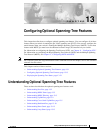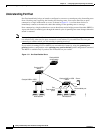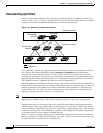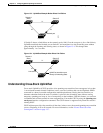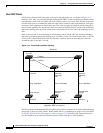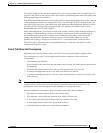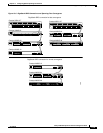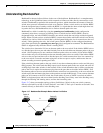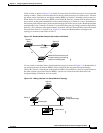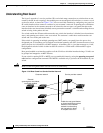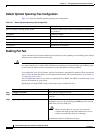
13-7
Catalyst 2950 Desktop Switch Software Configuration Guide
78-14982-01
Chapter 13 Configuring Optional Spanning-Tree Features
Understanding Optional Spanning-Tree Features
The switch sending the fast-transition request needs to do a fast transition to the forwarding state of a
port that it has chosen as the root port, and it must obtain an acknowledgement from each stack switch
before performing the fast transition.
Each switch in the stack determines if the sending switch is a better choice than itself to be the stack root
of this spanning-tree instance by comparing the root, cost, and bridge ID. If the sending switch is the
best choice as the stack root, each switch in the stack returns an acknowledgement; otherwise, it does
not respond to the sending switch (drops the packet). The sending switch then has not received
acknowledgements from all stack switches.
When acknowledgements are received from all stack switches, the Fast Uplink Transition Protocol on
the sending switch immediately transitions its alternate stack-root port to the forwarding state. If
acknowledgements from all stack switches are not obtained by the sending switch, the normal
spanning-tree transitions (blocking, listening, learning, and forwarding) take place, and the
spanning-tree topology converges at its normal rate (2 * forward-delay time + max-age time).
The Fast Uplink Transition Protocol is implemented on a per-VLAN basis and affects only one
spanning-tree instance at a time.
Events That Cause Fast Convergence
Depending on the network event or failure, the CSUF fast convergence might or might not occur.
Fast convergence (less than 1 second under normal network conditions) occurs under these
circumstances:
• The stack-root port link fails.
If two switches in the stack have alternate paths to the root, only one of the switches performs the
fast transition.
• The failed link, which connects the stack root to the spanning-tree root, recovers.
• A network reconfiguration causes a new stack-root switch to be selected.
• A network reconfiguration causes a new port on the current stack-root switch to be chosen as the
stack-root port.
Note The fast transition might not occur if multiple events occur simultaneously. For example, if a stack
member switch is powered off, and at the same time, the link connecting the stack root to the
spanning-tree root comes back up, the normal spanning-tree convergence occurs.
Normal spanning-tree convergence (30 to 40 seconds) occurs under these conditions:
• The stack-root switch is powered off, or the software failed.
• The stack-root switch, which was powered off or failed, is powered on.
• A new switch, which might become the stack root, is added to the stack.
• A switch other than the stack root is powered off or failed.
• A link fails between stack ports on the multidrop backbone.





